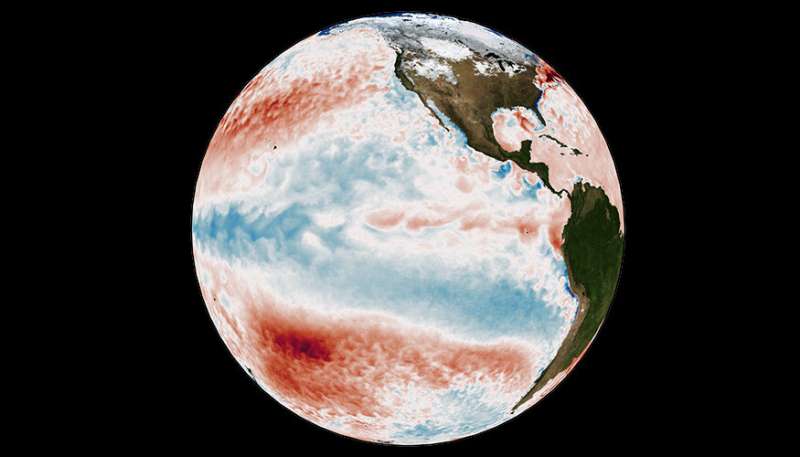Sea surface temperature anomalies illustrating the current La Niña event (courtesy of NOAA Coral Reef Watch) blended with the NASA January Blue Marble image. Credit: Lawrence Livermore National Laboratory
New research shows that naturally occurring climate variations help to explain a long-standing difference between climate models and satellite observations of global warming.
Satellite measurements of global-scale changes in atmospheric temperature began in late 1978 and continue to the present. Relative to most model simulations, satellite data has consistently shown less warming of Earth's lower atmosphere. This has led some researchers to conclude that climate models are too sensitive to greenhouse gas emissions, and thus are not useful for making future climate change projections.
Instead, the model-versus-satellite difference is largely driven by natural variations in the Earth's climate. "Natural climate variability has likely reduced the observed warming during the satellite-era" said Stephen Po-Chedley, a Lawrence Livermore National Laboratory (LLNL) climate scientist and lead author of a paper appearing in the Proceedings of the National Academy of Sciences.
The main driver of natural year-to-year variations in global climate is the El Niño-Southern Oscillation (ENSO). Every few years, ENSO produces an El Niño event, which results in widespread warming of the atmosphere and ocean lasting several months. The cold phase of ENSO is La Niña, which cools the atmosphere and gives rise to a distinct pattern of cooler-than-usual sea surface temperatures in the central and eastern tropical Pacific, with warmer waters to the north and south.
Many climate models produce ENSO variations, but the timing of these events is not specified in model simulations. "While models are intended to represent the average climate, its changes and realistic natural variations, they can only simulate the exact timing of natural climate events by chance," said Po-Chedley.
Some decades favor El Niño or La Niña events. Clustering of El Niño and La Niña events can create decadal oscillations that influence the rate of atmospheric warming. Simulations with coupled models of the atmospheric and ocean circulation produce such decadal oscillations, but their phasing will not necessarily match the real world during the satellite era.
Qiang Fu, professor at the University of Washington and an author of the study, notes that, "while it is well-known that natural variability can produce decade-long periods of subdued warming, this study demonstrates that it also can play an important role over the relatively long 40-year timescales that are relevant to satellite records."
Climate models typically simulate substantially more warming than satellite data in the tropical troposphere (the lowest region of the atmosphere, extending from the Earth's surface to a height of about 11 miles). This region of the atmosphere has been of particular interest in previous model-satellite comparisons.
The researchers revisited such comparisons, analyzing hundreds of simulations from the newest generation of global climate models. They found that natural climate variability is a key component of the differences between modeled and observed warming rates. Roughly 13 percent of the 400-plus simulations showed warming of the tropical troposphere within the range of satellite results. The model simulations that agree with the satellite record tend to exhibit a La Niña-like temperature change pattern, just like the observations.
Such agreement yields two important findings. First, despite claims to the contrary, current climate models can simulate warming of the tropical troposphere that is consistent with observations. Second, natural variability has likely reduced tropospheric warming over the satellite era, both in the real world and in simulations consistent with satellite warming rates.
Another significant finding of the study relates to the suggestion that differences between modeled and observed warming rates are due to errors in "climate sensitivity"—the size of the warming in response to increases in greenhouse gases.
"Models with both high and low sensitivity to greenhouse gas increases can produce simulations consistent with the warming estimated from satellites," Po-Chedley said. "In reconciling modeled and observed warming rates, it's pretty clear from our work that climate sensitivity is not the sole determinant of atmospheric warming. Natural variability is an important piece in the puzzle."
More information: Stephen Po-Chedley et al. Natural variability contributes to model–satellite differences in tropical tropospheric warming, Proceedings of the National Academy of Sciences (2021). DOI: 10.1073/pnas.2020962118
Journal information: Proceedings of the National Academy of Sciences
Provided by Lawrence Livermore National Laboratory
























